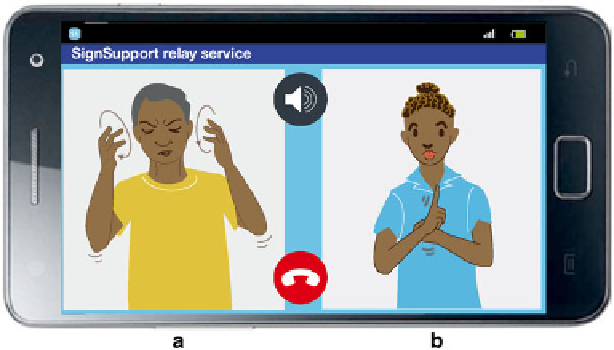Environmental Engineering Reference
In-Depth Information
Fig. 10.3
Side-by-side video orientation instead of picture-in-a-picture. User (
a
) is the deaf person,
and user (
b
) is the signed language interpreter (Figure adapted from Ma
2009
)
people not us. This is a classic example of Deaf participants helping to drive the
technical agenda as well as the research agenda. This user interface novelty was
carried over onto subsequent mobile prototypes (Wang and Tucker
2010
) and we
intend to continue using it in the future because Deaf people came up with the idea,
and they like it.
The SignSupport project was initiated on results obtained with participative
generative sessions. In our opinion, the experience that DPO staff had with us
during previous ICT studies, even though they were not being used, increased ICT
awareness to the extent that they were able to provide more informed feedback and
decisions during these sessions. This led to focussing solely on mobile devices, and
also solely on SASL interfaces for Deaf end users, including visual passcodes and
video reminders. This included investigation into icons meaningful to Deaf people
(Chininthorn et al.
2012
) and also careful attention to ensuring that recorded sign
language videos said exactly what they were supposed to say and were placed in
exactly the correct places (Motlhabi et al.
2013b
).
We also incorporated the code of ethics for pharmacists into the design of the
SignSupport application (SAPC
2010
). Integrating their code of ethics meant
changing the ordering of the user interface and introduced specifi c sections within
the application, e.g. the background information and confi rmation of identity.
Details of this can be found in Motlhabi et al. (
2013a
,
b
).
The eventual generality of SignSupport, in terms of scenarios, is going to support
self-determination even more because the Deaf community can decide what is
important to put into the application next. To do this, we are busy designing an
authoring tool to help domain experts create new SignSupport scenarios. The
authoring tool is an example of a technical research problem crafted by computer
scientists (because this is how we think - to generalise applications for wider usage).

Search WWH ::

Custom Search